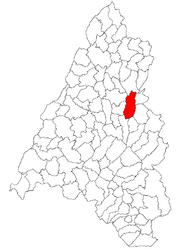Aleșd
Aleșd | |
|---|---|
 Aleșd Hospital, former Batthyany-Bethlen Castle | |
 Location within Bihor County | |
| Coordinates: 47°3′26″N 22°23′49″E / 47.05722°N 22.39694°E | |
| Country | Romania |
| County | Bihor |
| Government | |
| • Mayor (2020–2024) | Ioan Coloman Todoca[1] (PNL) |
| Area | 71.95 km2 (27.78 sq mi) |
| Elevation | 233 m (764 ft) |
| Population (2021-12-01)[2] | 9,662 |
| • Density | 130/km2 (350/sq mi) |
| Time zone | EET/EEST (UTC+2/+3) |
| Postal code | 415100 |
| Area code | (+40) 02 59 |
| Vehicle reg. | BH |
| Website | www |
Aleșd (Romanian pronunciation: [aˈleʃd] ⓘ; Hungarian: Élesd, Slovak: Alešď) is a town in Bihor County, western Romania. It administers three villages: Pădurea Neagră (Feketeerdő), Peștiș (Sólyomkőpestes), and Tinăud (Tinód).
Geography[edit]
The town is located in the east of the county, near the border with Cluj County, at the foot of the Apuseni Mountains. It lies on the banks of the river Crișul Repede, where the Vadu Crișului – Aștileu Canal connects with the river. The river Izvor flows into the Crișul Repede near Aleșd; the river Secătura flows into the Izvor in Peștiș village.
Aleșd is located on the CFR main railway line between Oradea and Bucharest. Consequently, it is served by frequent rapid and intercity (IC) trains from Cluj-Napoca, Bucharest, Arad, and Timișoara. Aleșd is located in the eastern part of Bihor County, on national road DN1 (European route E60), at a distance of 38 km (24 mi) from Oradea and 112 km (70 mi) from Cluj-Napoca.
History[edit]
At first Aleșd was on the shores of the Crișul Repede River (meaning ”The fast river”), in its floodplain. In the first half of the 18th century, the population moved to the terrace on the right bank of the Crișul Repede, in the place that it occupies today. The move was made to escape the frequent floods.
After the break-up of Austria-Hungary at the end of World War I, the Hungarian town passed under Romanian administration during the Hungarian–Romanian War of 1919, and became part of the Kingdom of Romania in April 1920. As a result of the Second Vienna Award, it was returned to Hungary in August 1940, staying under Hungarian administration until October 1944, towards the end of World War II. Aleșd was declared a town in 1968.
Population[edit]
| Year | Pop. | ±% |
|---|---|---|
| 1977 | 9,608 | — |
| 1992 | 10,920 | +13.7% |
| 2002 | 10,852 | −0.6% |
| 2011 | 9,619 | −11.4% |
| 2021 | 9,662 | +0.4% |
| Source: Census data | ||
According to the 2021 census, Aleșd has a population of 9,662.[3] At the census from 2011, the town had a population of 9,619, made up of Romanians (63.9%), Hungarians (16.04%), Roma (12.73%), Slovaks (6.59%), and others (0.42%).[4]
Administration[edit]
The town of Aleșd is run by a mayor and a local council composed of 17 councilors. The mayor, Ioan Coloman Todoca, from the National Liberal Party, was elected in 2016.
Notable residents[edit]
- Zsolt Bodoni, painter who lives in Oradea and was born in 1975 in Aleșd.
- Miklós Radnóti (1909–1944), poet and teacher who served his labor draft during World War II in Aleșd.
Gallery[edit]
-
Reformed church
-
Orthodox church
-
Roman Catholic church
-
Greek-Catholic church
-
Baptist prayer hall
-
The old Erzsébet Hotel
-
Létai House
-
Train station
References[edit]
- ^ "Results of the 2020 local elections". Central Electoral Bureau. Retrieved 9 June 2021.
- ^ "Populaţia rezidentă după grupa de vârstă, pe județe și municipii, orașe, comune, la 1 decembrie 2021" (XLS). National Institute of Statistics.
- ^ "Populația rezidentă după grupa de vârstă, pe județe și municipii, orașe, comune, la 1 decembrie 2021" (in Romanian). INSSE. 31 May 2023.
- ^ Romanian 2002 Census











